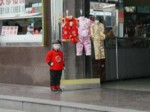
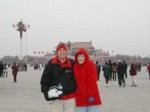
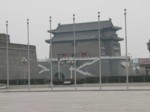
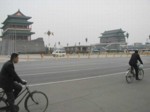
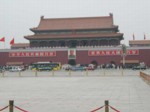
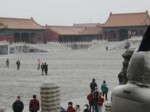
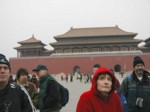
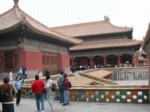
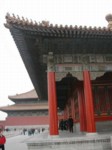
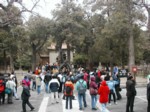
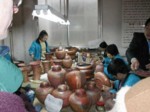
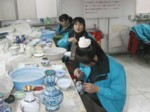
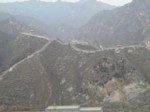
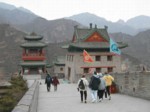
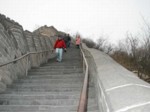
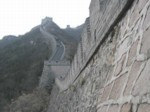
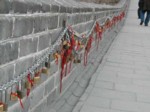
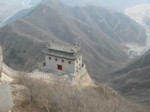
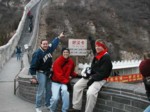
Since we arrived at our hotel in the evening and hadn't had much sleep while traveling for the previous day and a half, we both had a good night's sleep last night and woke up feeling refreshed and pretty much oriented to our new time zone - Beijing is 13 hours ahead of Louisville. We head downstairs and find that the Jinglun Hotel has an excellent breakfast buffet – a good mix of Chinese and Western dishes. I have bread with butter and jelly, fried rice, bacon, and fruit along with a cup of hot tea. Because the water has been boiled, hot tea is a pretty safe drink choice. In the dining room we meet several other couples from our adoption group who arrived in China before us. Apparently our little group from the previous night was the last to arrive. After breakfast we board a tour bus for our day of sightseeing in Beijing.
Beijing is incredibly densely populated! The streets are packed with busses, cars, bikes, and pedestrians. The high-rises around our hotel are interspersed with what Cynthia refers to as “match box apartments". These are tall buildings (20 or 30 floors) filled with tiny apartments, lined up for block after block. Although I’m sure that they exist, we see no single-family dwellings in Beijing (nor anywhere else we visit in China). For being so big and densely populated, we’re struck by how clean and nice Beijing is. The streets and sidewalks are free of trash and seem to be kept in excellent condition. I’m sure there are plenty of places in this city where this is not the case, but we didn't see them.
Our first stop is Tiananmen Square, which turns out to be quite close to our hotel. The square is huge - 100 acres of pavement which can accomodate over 500,000 people! The square is flanked on either side by large government buildings. At one end is the Tiananmen Gate (or Gate of Heavenly Peace), which is a large red gate bearing a picture of Mao Tse Tung which leads to the Forbidden City (more on that later). At the other end of the square is Mao’s mausoleum. A long line of Chinese snakes up the stairway leading to the tomb. They're waiting to enter and get a glimpse of his body which, after his death, was preserved and put on public display. Beside Mao's mausoleum are the ancient Quianmen Gates, which were originally part of the wall that surrounded Beijing and protected the city from invasion.
It’s windy and quite cold on the square and we’re glad that we thought to pack our hats and gloves. Those of our group who didn’t are quickly outfitted by street vendors. These vendors are everywhere, selling hats, gloves, books, and postcards and trying very hard to pass off counterfeit Yuan to unsuspecting tourists. The slightest sign of interest prompts a relentless sales pitch - we quickly learn to just ignore them. We also see lots of soldiers in the square, wearing crisp green uniforms and marching or standing at attention before the buildings. Up close we see that they’re quite young, just boys really, but they look quite serious. There are plenty of tourists as well (nearly all Chinese) but it’s not crowded at all because it’s such a vast space.
After a brief orientation from Cynthia, the group splits up and we make a quick circuit of the square, looking at the buildings and snapping pictures. As we walk I’m struck by the realization that I’m actually in China and I’m actually standing in the middle of Tiananmen Square - it’s staggering! After about 30 minutes we regroup at the far end of the square, where Cynthia is waiting for us. She leads us down a flight of steps, though a pedestrian tunnel which crosses under a busy street, and then back up on the other side to emerge in front of the Tiananmen Gate. These pedestrian tunnels are quite popular in China - with all of the crazy traffic it would be nearly impossible to cross at street level. We pass through a large opening in the Tiananmen Gate, directly below the enormous portrait of Chairman Mao, and find ourselves inside the Forbidden City. This is the ancient palace complex which was used for centuries by Chinese emperors. These days it's officially known as the Palace Museum, but no one actually uses that name, everyone still refers to it as the Forbidden City. It’s amazing to be in a legendary place like this!
Within the Forbidden City we seem to attract more attention from the locals – nothing unfriendly, just curiosity. We stop for a group photo and many of the Chinese tourists stop to look, smiling and snapping pictures of us. There’s one Caucasian child with our group, a blond girl who is 7 or 8 years old. As we pass through the Forbidden City several Chinese families stop and ask if she’ll pose for a picture with their children. She doesn’t mind, but seems puzzled as to how she's become such a celebrity.
The Forbidden City itself is a massive walled complex (186 acres) filled with beautiful buildings. The buildings all feature elaborate carvings and fancy curved roof lines. No trees grow within the complex - we’re told that because all of the buildings are constructed of wood the emperors were very afraid of fire. The open spaces between buildings are all paved with stones. Gigantic iron cauldrons which were used to hold water for fighting fires are everywhere.
Cynthia does a excellent job guiding us through the Forbidden City and explaining its history. She carries a small blue FTIA flag on a telescoping pole and we quickly become conditioned to follow the flag like a line of ducklings following their mother. We notice quite other tour groups following flags of various colors. It’s really quite useful in some of the crowded places we’ll visit.
At the exit to the Forbidden City we stop for a bathroom break before boarding our bus. Cynthina explains to us that there are no Western toilets here, only Chinese. I realize that this is what the strange fixture I saw in the Tokyo airport was. Chinese toilets are porcelain bowls set level with the floor, over which one squats to do one’s business. It seems like it would require strong leg muscles and a pretty good sense of balance to use them. Thankfully I don’t have to find out. We soon take to referring to them as “squat pots”. Toilet paper is strictly bring your own, and is not flushed after being used, but is instead deposited in a basket beside the toilet.
We climb back onto our tour bus and head for lunch. For the first half hour we drive very slowly through heavy traffic – cars, busses, bicycles, and pedestrians. Both sides of the street are lined tiny shops. The function of some, like the fruit shop, is obvious, while others we can only guess at. In this section of Beijing things are not so clean and new as they were in the area around our hotel. This is much closer to what I had imagined China would be like.
Traffic flow in Beijing is, to say the least, unconventional. The streets are filled with cars, taxis, busses, bicycles, and pedestrians. All of these vehicles merge and flow following a set of rules which we could never quite puzzle out. Horns sound continuously, but no one seems to be getting angry - apparently they’re using their horns to signal to one another. The traffic flow is quite cooperative, no one ever comes to a full stop, they just slow to let opposing traffic merge in. At times it’s quite unnerving to watch out of the window as our bus makes a turn through a line of pedestrians and bicycles which never actually stops moving. But everyone seems to be following the same set of rules and we’ve seen no accidents yet.
We finally reach the highway - the traffic, and buildings, quickly thin. Now we pass orchards and dairies and even spot several horse drawn carts pulling loads of stones along a small road which parallels the highway. In the distance tall jagged hills (perhaps mountains?) begin to appear. We’re getting close to the Great Wall!
But before we get to see the Great Wall we need to stop for lunch. The bus pulls into the parking lot of a large retail building, the Friendship Shop. Cynthia tells us that we’ll have an hour or so here for lunch and shopping. The inside of the Friendship Shop is a vast space filled with all kinds of Chinese crafts: silks, jade, prints, wood carvings, and the specialty of this shop, cloisonné. We start with a brief tour of the cloisonné factory. Women are seated at benches creating beautiful vases in assembly line fashion, with the pieces being passed from person to person for the completion of each step. First fine copper wire is applied to a bare copper pot forming the outlines of the image to be created. Then each space in the wire frame is filled with enamel powder. The pot is fired in a kiln to melt the enamel and, once the pot is cool, it is polished to smooth the enamel and make it shine. Layer after layer of enamel is applied, fired, and polished during the creation of each piece of cloisonné. It’s incredibly detailed work which is all done painstakingly by hand.
After our tour we head upstairs for lunch and the much welcome luxury of bathrooms with Western style toilets. Our group is seated at several large round tables with rotating centers where we’re served by waitresses in bright red or blue outfits with little hats – they look just like airline stewardesses from the 1950’s. The waitresses place dish after dish of delicious food on the rotating portion of our table. We sample everything, spinning the center of the table to bring around whichever dish we want. The food is excellent and we’re quite full by the time lunch is over.
After a brief period of shopping we get back on the bus and within minutes catch our first glimpse of the Great Wall! The wall snakes along the mountains in front of us, hugging each contour of the mountainside. We’re visiting the Juyong Pass, which features a looping section of the Great Wall. This portion of the wall is very steep and, due to recent refurbishment, is in excellent condition. Although this section is still reasonably close to Beijing, it is not as popular with the tourists as other, closer sections are.
The wall is built of large irregular stones which were carefully fitted together to leave no gaps between them. It’s roughly 20 feet in height and is topped by a path which is generally broad enough for 3 people to walk side-by-side. The path is flanked by sidewalls which are 3 to 4 feet high. Elaborate guard houses are strung along the wall, spaced about 100 yards or so apart. Much of the path is made up of steps which are irregular (both in height and depth) and very steep – the climb is exhausting. Prior to coming here I noticed that people didn’t talk about “visiting” the Great Wall or “strolling along” the Great Wall, instead they “climbed” the Great Wall. Now I understand.
There are a fair number of tourists at the bottom, but they quickly thin as we climb higher and higher. Mike and I leave the rest of our group and climb to what appears to be the highest guard tower, only to find that the wall curves back and continues its climb to another tower which wasn’t visible from below. Upon reaching that tower we find that there is still another, higher, tower beyond. We’re tired and close to being out of time so we abandon our quest for the highest point and begin our descent. Coming back down isn’t as physically exhausting as climbing was, but it requires a lot of concentration to navigate the steep, irregular steps – especially when you’re tired.
Back at the bottom we treat ourselves to “I Climbed the Great Wall” tee-shirts and Cokes from the souvenir shop (some things are universal) and then it’s back on the bus for the return trip to the hotel. On the way back Cynthia outlines our activities for the next few days. Most important, of course, is that tomorrow we’ll be getting our babies – everyone on the bus is excited and anxious! As we ride, Cynthia passes out copies of questionnaires which, at the request of FTIA, were completed by the various orphanages from which our group will be adopting. We receive two pages of questions and answers (in Chinese with English translations) about our new baby. Most of the information is pretty much the same as what we read in the developmental reports that came with our referral packet. We do find out that her favorite food is steamed eggs, she likes all kinds of toys, and she doesn't seem to be afraid of anything. The answer to the final question, regarding her personality, is intriguing. The orphanage responds that "Chun Xian is outgoing. She is an active girl."
The trip back takes about an hour and it’s nearly dark when we get arrive at the hotel. We trudge wearily back up to our room for room service and sleep. Tomorrow, babies!
| Previous | Home | Next |